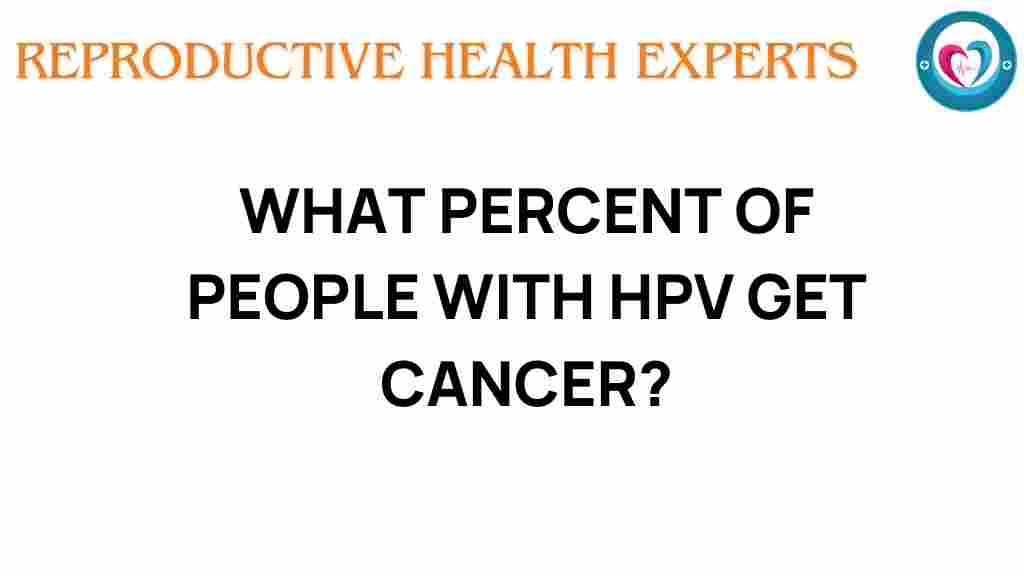Unraveling the Mystery: What Percentage of HPV Cases Lead to Cancer?
Human Papillomavirus (HPV) is a term that resonates with many when discussing sexual health, yet its implications can be misunderstood. While HPV is the most common sexually transmitted infection, a common question arises: what percentage of HPV cases lead to cancer? Understanding this relationship is crucial for awareness, prevention, and overall public health. In this article, we will delve into the statistics surrounding HPV and cancer, explore health risks, and discuss prevention methods.
Understanding HPV and Its Types
Human Papillomavirus is a group of more than 200 related viruses, with over 40 types that can be transmitted through direct skin-to-skin contact, primarily during sexual activity. Among these, some types are classified as high-risk due to their potential to cause cancer.
- High-Risk HPV: Types 16 and 18 are responsible for approximately 70% of cervical cancer cases.
- Low-Risk HPV: Types 6 and 11 often cause genital warts but are less likely to lead to cancer.
Statistics on HPV and Cancer
According to the Centers for Disease Control and Prevention (CDC), about 79 million Americans are currently infected with HPV, and around 14 million people become newly infected each year. While most HPV infections resolve on their own, a significant concern is the percentage that leads to cancer.
HPV and Cervical Cancer
Among women, persistent infection with high-risk HPV can lead to cervical cancer. The statistics are alarming:
- Nearly all cervical cancer cases (over 99%) are linked to HPV.
- About 12,000 women in the United States are diagnosed with cervical cancer each year.
- Approximately 4,000 women die from cervical cancer annually in the U.S.
It is estimated that 5-10% of women infected with high-risk HPV will develop cervical cancer over their lifetime. However, this percentage can vary based on various factors, including the presence of other health conditions, smoking, and immune system status.
HPV and Other Cancers
Besides cervical cancer, HPV is also associated with several other cancers, including:
- Oropharyngeal Cancer: HPV is linked to about 70% of oropharyngeal cancers.
- Anal Cancer: Approximately 90% of anal cancers are associated with HPV.
- Penile Cancer: HPV is found in about 50% of penile cancer cases.
- Vulvar and Vaginal Cancer: These cancers are also linked to high-risk HPV types.
The overall risk of developing cancer from HPV varies, but ongoing research aims to provide more clarity on the exact percentages related to each type of cancer.
Health Risks Associated with HPV
While HPV is often asymptomatic, the health risks associated with persistent infection are serious. Factors that increase the risk of developing cancer include:
- Persistent infection with high-risk HPV types.
- Weakened immune systems (due to HIV, organ transplants, etc.).
- Smoking and tobacco use.
- Long-term use of oral contraceptives.
- Having multiple sexual partners.
Awareness of these factors is vital for identifying individuals at higher risk for cancer, enhancing prevention strategies, and encouraging regular health screenings.
Prevention of HPV-Related Cancers
Preventing HPV infection and its potential complications, including cancer, involves a multi-faceted approach:
- Vaccination: The HPV vaccine is highly effective in preventing infections from the most common high-risk HPV types. The CDC recommends the vaccine for preteens aged 11-12, but it can be administered up to age 26 (and even older in some cases).
- Regular Screening: Women should undergo regular Pap tests and HPV testing as recommended, which can detect precancerous changes in cervical cells.
- Safe Sex Practices: Using condoms and dental dams can lower the risk of HPV transmission, although they do not provide complete protection.
- Limit Number of Sexual Partners: Reducing the number of sexual partners can decrease the likelihood of HPV exposure.
- Avoid Tobacco: Quitting smoking can improve overall health and reduce cancer risk.
Raising Awareness about HPV and Cancer
Public health initiatives play a crucial role in raising awareness about HPV and its link to cancer. Here are some strategies that can be implemented:
- Education Campaigns: Informing the public about HPV transmission, health risks, and preventive measures is essential.
- Community Outreach: Engaging communities through workshops, seminars, and health fairs can promote vaccination and screening.
- Collaboration with Healthcare Providers: Encouraging healthcare professionals to discuss HPV with patients can increase awareness and vaccination rates.
For more information about HPV statistics and prevention, you can visit the CDC HPV page.
Troubleshooting Common Misconceptions About HPV
Despite the wealth of information available, several misconceptions about HPV persist:
- Myth: Only promiscuous individuals get HPV.
- Fact: HPV is so common that nearly all sexually active individuals will contract it at some point in their lives.
- Myth: HPV is only a concern for women.
- Fact: HPV can affect anyone, and men can also develop HPV-related cancers.
- Myth: The HPV vaccine is unnecessary if you are already sexually active.
- Fact: The vaccine can still provide protection against strains of HPV you have not been exposed to.
Conclusion
Unraveling the mystery of HPV and its relationship to cancer is essential for public health. While a significant percentage of HPV cases can lead to cancer, particularly cervical cancer, awareness and prevention strategies can mitigate these risks. Vaccination, regular screenings, and safe sex practices are critical in reducing the incidence of HPV-related cancers.
By prioritizing education and awareness, we can empower individuals to take control of their health, reduce stigma, and ultimately save lives. Whether you are a healthcare provider, educator, or individual, your role in spreading awareness about HPV is vital in the fight against cancer.
For more insights on HPV and cancer, consider checking out our other articles on related topics. Together, we can make a difference in public health and awareness.
This article is in the category Conditions and created by ReproductiveHealthExperts Team
